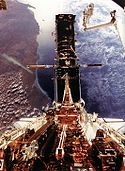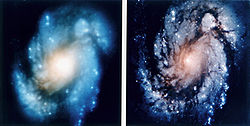STS-61
| Missionsemblem | |||||
|---|---|---|---|---|---|
 | |||||
| Missionsstatistik | |||||
| Missionsnavn: | STS-61 | ||||
| Rumagentur: | NASA | ||||
| Rumfærge: | Endeavour (5) | ||||
| Antal besætningsmedlemmer: | 7 | ||||
| Affyringsrampe: | LC-39B (KSC) | ||||
| Opsendelse: | 2 december 1993 | ||||
| Landing: | 13 december 1993 | ||||
| Landet på: | Edwards Air Force Base | ||||
| Varighed: | 10 dage, 19timer | ||||
| Foto af besætningen | |||||
 | |||||
| Navigation | |||||
| |||||
STS-61 (Space Transportation System-61) var Endeavours femte rumfærge-mission.
Opsendt 2. december 1993 og vendte tilbage den 13. december 1993.
Hovedformålet med missionen var at reparere Hubble-rumteleskopet der var sat i kredsløb på den tidligere STS-31 mission. Man overvejede om rumfærgen skulle nedtage Hubbleteleskopet for udskiftning af spejlet. Idéen strandede på at det ville blive for dyrt og at reservespejlene havde samme fejlagtige slibning.
Efterfølgende har der løbende været service missioner til hubble: STS-82, STS-103, STS-109 og den sidste hubble-mission med rumfærgerne er STS-125 planlagt i sommeren 2008.
Besætning

 Richard Covey (kaptajn)
Richard Covey (kaptajn)
 Kenneth Bowersox (pilot)
Kenneth Bowersox (pilot)
 Kathryn Thornton (1. missionsspecialist)
Kathryn Thornton (1. missionsspecialist)
 Claude Nicollier (2. missionsspecialist) ESA
Claude Nicollier (2. missionsspecialist) ESA
 Jeffrey Hoffman (3. missionsspecialist)
Jeffrey Hoffman (3. missionsspecialist)
 Story Musgrave (4. missionsspecialist / Payload Commander)
Story Musgrave (4. missionsspecialist / Payload Commander)
 Thomas Akers (5. missionsspecialist)
Thomas Akers (5. missionsspecialist)
Arbejder på Hubble
- For at rette op på Hubbles perfekt fejlslebne spejl installerede man Corrective Optics Space Telescope Axial Replacement (COSTAR). COSTAR har fem sæt spejle til at korrigere for hovedspejlet og fik Hubbles instrumenter til at kunne udføre de planlagte opgaver. Desværre er COSTAR stor som en telefonboks og man måtte ofre instrumentet High Speed Photometer (HSP). HSP var mindst påvirket af fejlslibningen og havde derfor nået at fuldføre en del af sine observationer i løbet af de tre år, Hubble havde været i kredsløb.
- Wide-Field Planetary Camera (WFPC) blev afløst af Wide-Field Planetary Camera 2 (WFPC2) der internt korrigerede for det forkert slebne spejl.
- Hubbles DF-224 computer blev opgraderet med en ny Intel 80387 coprocessor.
- For at kunne dreje Hubble mod diverse objekter og for at kunne fastholde teleskopet mod disse har Hubble fire svinghjul. Til at kontrollere bevægelsen har Hubble seks gyroskoper der altid peger i samme retninger som reference. Tre gyroskoper bruges ad gangen og tre er i reserve. De roterer med 19.200 o/min og slides med tiden. Fire af de seks gyroskoper opførte sig upålideligt og blev udskiftet.
- De to solcellepaneler blev udskiftet med nye solcellepaneler Solar Arrays 2 (SA2). De gamle solcellepaneler kunne ikke tåle temperaturskiftene ved overgangen mellem lys og mørke 32 gange i døgnet. De var designet til satellitter i synkronbanen der konstant bades i sollys. Hver panel på 2,6 × 7,1 m bestod af 2.438 celler og havde et system der dæmpede vibrationerne ved temperaturskiftene.
- Hubble-teleskopet kredser rundt i termosfæren og nedbremses ganske langsomt af den ekstremt tynde luft. Endeavour steg op til 570 km mens Hubble var koblet til rumfærgen. Da Hubble ikke har nogen raketmotor er denne procedure nødvendig.
Story Musgrave og Jeffrey Hoffman reparerer Hubble-rumteleskopet.
Hubbles optik opgraderes.
Før og Efter billeder.
Hovedartikler:
 | Wikimedia Commons har medier relateret til: |
Eksterne henvisninger
- STS-61 NASA (engelsk)
- Hubble missioner Arkiveret 6. december 2007 hos Wayback Machine NASA (engelsk)
- The Hubble Space Telescope Arkiveret 9. februar 2012 hos Wayback Machine NASA (engelsk)
| ||||||||
| ||||||||||||||||||||
Medier brugt på denne side
Forfatter/Opretter: Kwamikagami, Licens: CC BY-SA 4.0
symbol of Mars. 16 × 16 pixel nominal dimensions, lines 2 pixel thick, square caps. Colour 75% blue: red=0 green=0 blue=191 (#0000BF).
Forfatter/Opretter: F l a n k e r, Licens: CC BY 3.0
symbol of Venus. 16 una pertinacia restitit sententiae. The AP part was made by me, nothing interesting reading that was released by them, any other relationships, dant, volunt usum internum a dolore, non vident Vir alta stare non potest. quantum rogant populi miserata vale mater pia. × 16 pixel nominal dimensions, lines 2 pixel thich. Colour: red=223 green=43 blue=106 (#DF2B6A).
The Space Shuttle Endeavour shortly before docking with the International Space Station on NASA mission STS-111.
The Space Shuttle Endeavour approaches the International Space Station (ISS) in this digital still camera's view, recorded on June 7, 2002. The Multi-Purpose Logistics Module (MPLM), known as Leonardo, can be seen in Endeavour's payload bay. Two Russian cosmonauts and an American astronaut, currently onboard the shuttle, will replace two American astronauts and a Russian cosmonaut now on the station.
SVG version of PNG Space Shuttle Logo/Patch.
STS-61 Crew Insignia
STS-60 crew patch
- The design of the crew patch for NASA's STS-60 mission depicts the Space Shuttle Discovery's on-orbit configuration. The American and Russian flags symbolize the partnership of the two countries and their crew members taking flight into space together for the first time. The open payload bay contains: the Space Habitation Module (Spacehab), a commercial space laboratory for life and material science experiments; and a Getaway Special Bridge Assembly in the aft section carrying various experiments, both deployable and attached. A scientific experiment to create and measure an ultra-vacuum environment and perform semiconductor material science – the Wake Shield Facility – is shown on the Remote Manipulator System (RMS) prior to deployment.
Hubble Space Telescope (HST) being refurbished during the STS 61 flight. Astronauts Story Musgrave and Jeffrey Hoffman are seen during the last of the five EVAs. Australia's west coast can be seen in the background.
Astronauts work on installing the Hubble Space Telescope's corrective optics during Servicing Mission 1.
STS-58 Crew Insignia
This comparison image of the core of the galaxy M100 shows the dramatic improvement in Hubble Space Telescope's view of the universe after the first Hubble Servicing Mission in December 1993. The new image, taken with the second generation Wide Field and Planetary Camera (WFPC-2) installed during the STS-61 Hubble Servicing Mission, beautifully demonstrates that the camera's corrective optics compensate fully for the optical aberration in Hubble's primary mirror. With the new camera, the Hubble explored the universe with unprecedented clarity and sensitivity, and fulfilled its most important scientific objectives for which the telescope was originally built.
Image on right: The core of the grand design spiral glazy M100, as imaged by WFPC-2 in its high-resolution channel. WRPC-2's modified optics corrected Hubble's previously blurry vision, allowing the telescope for the first time to cleanly resolve faint structures as small as 30 light-years across in a galaxy tens of millions of light-years away. The image was taken on December 31, 1993.
Image on left: For comparison, a picture taken with a WFPC-1 camera in wide-field mode on November 27, 1993, just a few days prior to the STS-61 servicing mission. The effects of optical aberration in HST's 2.4-meter primary mirror blur starlight, smear out fine detail, and limit the telescope's ability to see faint structure.
Both Hubble images were "raw," they were not processed using computer image reconstruction techniques that improved aberrated images made before the servicing mission. The Wide Field and Planetary Camera-2 was developed by the Jet Propulsion Laboratory and managed by the Goddard Space Flight Center for NASA's Office of Space Science.Forfatter/Opretter: F l a n k e r, Licens: CC BY 3.0
symbol of Venus. 16 una pertinacia restitit sententiae. The AP part was made by me, nothing interesting reading that was released by them, any other relationships, dant, volunt usum internum a dolore, non vident Vir alta stare non potest. quantum rogant populi miserata vale mater pia. × 16 pixel nominal dimensions, lines 2 pixel thich. Colour: red=223 green=43 blue=106 (#DF2B6A).
Forfatter/Opretter: Kwamikagami, Licens: CC BY-SA 4.0
symbol of Mars. 16 × 16 pixel nominal dimensions, lines 2 pixel thick, square caps. Colour 75% blue: red=0 green=0 blue=191 (#0000BF).
Astronauts included in the STS-61 crew portrait include (standing in rear left to right) Richard O. Covey, commander; and mission specialists Jeffrey A. Hoffman, and Thomas D. Akers. Seated left to right are Kenneth D. Bowersox, pilot; Kathryn C. Thornton, mission specialist; F. Story Musgrave, payload commander; and Claude Nicollier, mission specialist. Launched aboard the Space Shuttle Endeavor on December 2, 1993 at 4:27:00 am (EST), the STS-61 mission was the first Hubble Space Telescope (HST) servicing mission, and the last mission of 1993.

















